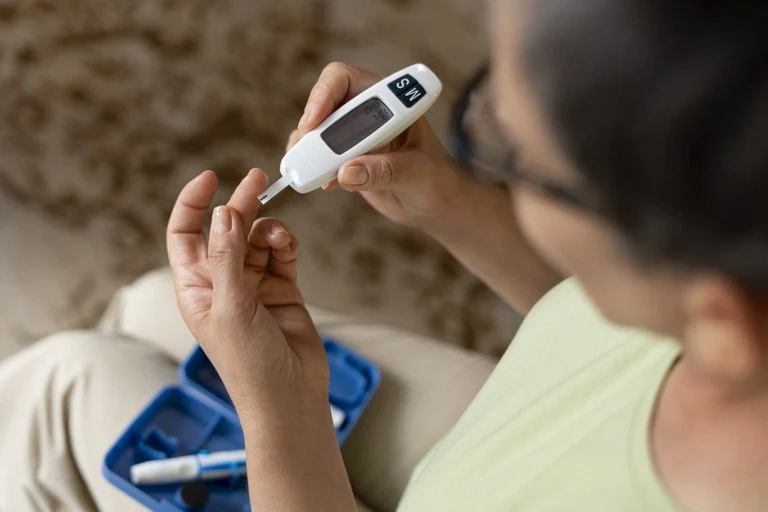Understanding Your A1C: Frequently Asked Questions for Diabetes Management

The Hemoglobin A1C (or glycated hemoglobin) test is the bedrock of diabetes monitoring, offering a crucial long-term view of glucose management. It measures the average impact of sugar in your blood and helps predict the risk of complications.
READ ALSO:
- Quick Exercise for Lower Back Pain Relief: Simple Moves That Work
- Does Running Help You Lose Weight? How to Start and Progress Without Losing Your Breath
Follow our PAGE
What Exactly Is A1C and What Does It Measure?
The A1C is a blood test that quantifies the glucose that has attached itself to hemoglobin, a protein found in red blood cells.
- Long-Term Measurement: Red blood cells live for about 3 months. Therefore, the A1C provides an average of glucose levels over the preceding quarter.
- Essential Function: It serves as a “summary” of your glucose management, vital for diagnosis and for monitoring the effectiveness of your treatment plan and medication.
A1C Levels: Diagnostic Ranges
A1C results are reported as a percentage. The higher the percentage, the higher your average blood glucose level has been.
| A1C Level (%) | Diagnosis | Meaning |
| Below 5.7% | Normal | Indicates you do not have diabetes. |
| 5.7% to 6.4% | Prediabetes | Signals an elevated risk of developing type 2 diabetes. |
| 6.5% or higher | Diabetes | Confirms a diabetes diagnosis. |
What is the Target?
The ideal target is always individualized and should be set with your doctor. However, the standard goal set by the American Diabetes Association (ADA) for most non-pregnant adults is to keep A1C at 7% or below, provided this does not result in frequent episodes of hypoglycemia (dangerously low blood sugar).
The Relationship to Daily Blood Glucose (eAG)
Many people find it difficult to relate the percentage A1C result to the readings they take on their daily glucose meters (in mg/dL). To help with this, scientists created the Estimated Average Glucose (eAG).
The eAG is a calculation that “translates” your A1C result into the same unit of measure as daily glucose tests, making the result more relatable:
| A1C (%) | eAG (mg/dL) |
| 6% | 126 |
| 7% | 154 |
| 8% | 183 |
| 9% | 212 |
Testing Frequency and Accuracy
How Often Should I Get an A1C Test?
- Routine Monitoring: The A1C is typically checked twice a year (every 6 months) after the initial diagnosis.
- Treatment Adjustment: If your glucose is off target, or if your treatment plan has been changed, the test may be ordered every 3 months (four times a year).
- Convenience: A major advantage of the A1C is that it does not require fasting and can be done at any time of the day.
Is A1C Entirely Accurate?
A1C is generally considered highly accurate, but it is essential to know that several factors can influence the results:
- Health Conditions: Kidney or liver disease, severe anemia (including iron deficiency), recent blood loss, and blood transfusions can affect the lifespan of red blood cells, potentially distorting the result.
- Medications: Certain medications, including some for HIV or opioids, can also influence the reading.
- The Limitation of the Average: The A1C is an average. It does not reveal the major glucose fluctuations (spikes and dips) that occur throughout a day. A patient may have a “good” (low) A1C due to frequent hypoglycemia, which does not reflect good management.
The Importance of Time in Range (TIR)
Because of the A1C’s limitation in capturing fluctuations, the concept of Time in Range (TIR) is gaining prominence, especially with the use of Continuous Glucose Monitors (CGMs).
- What is TIR: TIR calculates the percentage of time a person’s glucose remains within their safe target range (usually between 70 and 180 mg/dL).
- Goal: The aim for good glucose management is to spend at least 70% of the time within the target range.
This more nuanced view complements the A1C, giving the medical team more complete information to adjust your care plan.
Conclusion and Next Steps
The A1C remains a useful and fundamental tool in the overall management of diabetes. While it doesn’t replace daily glucose monitoring, it provides a crucial long-term picture of your blood sugar control.
With advancing technology and the increased use of CGMs, A1C is evolving: from being the single dominant measure for diabetes management, it is now considered one of several essential metrics for ongoing monitoring and goal setting.
The most important step is to talk regularly with your healthcare team. They can help you understand your A1C result, determine your individualized goal, and decide on the best combination of diet, exercise, and medication to optimize your treatment and reduce the risk of complications.

Hello! My name is Alan Teixeira and I am passionate about helping people live healthier, more balanced lives. From mindful eating to daily habits that promote physical and mental well-being, I believe that small, consistent changes can lead to powerful transformations.
I created this blog to share practical tips, reliable information, and thoughtful insights that can inspire you to take better care of yourself—with balance, mindfulness, and positivity.
If you are looking to improve your health, nourish your body, and build a lighter, more fulfilling routine, you are in the right place. Welcome!


